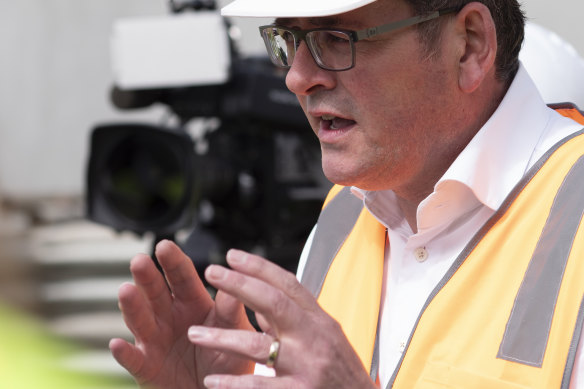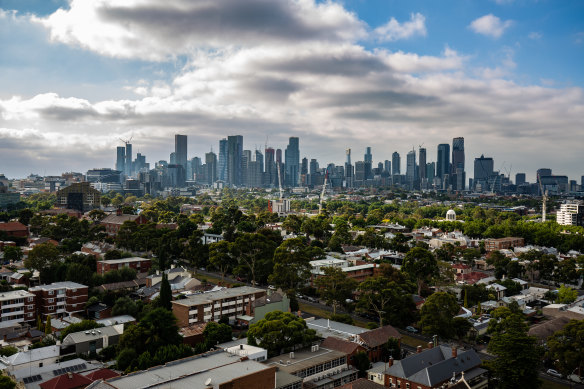Don’t expect a quick fix on housing – even if everything goes to plan

Save articles for later
Add articles to your saved list and come back to them any time.
Daniel Andrews says his friends and neighbours tell him they are worried about where their children and grandchildren will be able to afford a home.
“They are genuinely concerned about where their kids will live, and where they’ll have to travel to to go and see their grandchildren,” the premier said on Wednesday after releasing the government’s long-awaited housing statement.
Daniel Andrews on Wednesday releasing what he says is the most significant planning overhaul in the state’s history.Credit: Elke Meitzel
But anyone hoping their kids will soon be able to afford a house around the corner should not hold their breath.
If everything goes according to plan and the government’s ambitious agenda to deliver 80,000 new houses every year for the next decade is realised, the state will only narrowly get ahead of population growth.
On current projections, the best we can hope for is that access to apartments and townhouses might improve somewhat over the medium to long term.
Victoria is once again Australia’s fastest-growing state. By 2051 it is expected to swell by half to 10.3 million, up from about 6.8 million now.
The government hopes to squeeze more homes into Melbourne’s established suburbs.Credit: Scott McNaughton
Melbourne is expected to grow by about 1 million people – topping 6 million – over the next 10 years and is tipped to overtake Sydney early next decade. About three-quarters of the city’s additional inhabitants will be overseas migrants.
Victoria – as with other jurisdictions – is already facing serious demographic, economic, planning and social challenges
As the housing statement points out, national housing affordability is at its lowest ebb in at least three decades, due to soaring interest rates and house prices.
It also says a family earning a median income of $105,000 can now afford just 13 per cent of homes on the market, the lowest share since records started in the early 1990s. For lower-income households, the situation is particularly dire. A family earning $64,000 can now afford just 3 per cent of homes on the market.
It now takes a typical Victorian household more than six years to save up for a deposit on a house, compared with about 3.6 years in the early 2000s.
According to the government’s modelling, Victoria will need to build about 57,000 homes each year to merely tread water and prevent the situation from getting even worse. That means a total of about 1.6 million new residences by 2051.
But if the state has any hope of easing the “acute” pressure, it will need to deliver more than 2.2 million homes by 2051. That’s where the government’s ambition to deliver 80,000 homes a year comes in.
Put another way, seven out of every 10 new houses delivered in the government’s plan will be needed just to soak up expected population growth. The remaining three will boost the housing supply to – theoretically – drive down prices.
This might help the situation over the longer term, but there will be no quick fix for the children of Andrews’ neighbours and friends.
Tackling the state’s housing woes will be tricky and it will take time. That’s just a demographic reality.
There are, of course, important components of the government’s housings statement that will help.
Rezoning “surplus” government land across 45 sites to deliver at least 9000 new homes is a good idea. As is streamlining planning processes for housing developments worth at least $50 million in Melbourne if they deliver at least 10 per cent affordable housing, including build-to-rent projects.
And with more younger people shut out from the market and forced to confront the reality of renting long term, providing tenants with added security over their leases and better mechanisms for resolving disputes makes good sense.
The decision to redevelop Melbourne’s 44 high-rise social housing towers will have a profound impact on the city.
However, there are significant gaps. The statement is particularly vague about what is meant by “affordable housing”, although the term is used 27 times.
What will be the eventual mix between public housing and “affordable housing”? When the government talks about affordable housing, what does it even mean? Affordable for whom? Will this just be an easy concession for property developers wanting to fast-track developments?
Under one benchmark previously used by the government – as reported this month by this masthead – to qualify as “affordable”, the rent for a home must be set 10 per cent below the area’s median market rate and absorb no more than 30 per cent of a household’s median income.
For a public housing tenant, or even a low- to moderate-income household, that might be cold comfort.
As this masthead previously reported, a single adult with an income of $59,540 – the mid-point of the government’s “moderate” income band – would currently have to pay more than 30 per cent of their income in rent for an “affordable” home across every one of Melbourne’s 31 municipalities.
Get the day’s breaking news, entertainment ideas and a long read to enjoy. Sign up to receive our Evening Edition newsletter.
Most Viewed in National
From our partners
Source: Read Full Article


